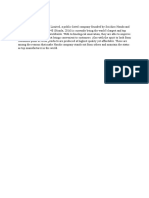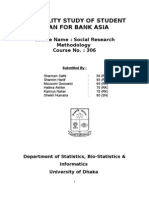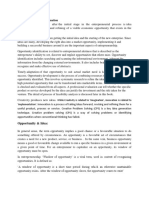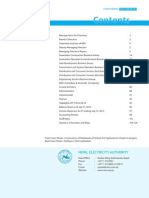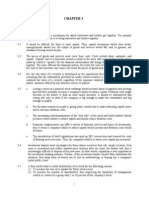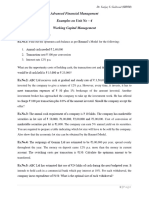Feasibility Study Questions
Feasibility Study Questions
Uploaded by
Pat Hadji AliCopyright:
Available Formats
Feasibility Study Questions
Feasibility Study Questions
Uploaded by
Pat Hadji AliOriginal Description:
Copyright
Available Formats
Share this document
Did you find this document useful?
Is this content inappropriate?
Copyright:
Available Formats
Feasibility Study Questions
Feasibility Study Questions
Uploaded by
Pat Hadji AliCopyright:
Available Formats
FEASIBILITY STUDY
Enumeration (9pts)
Costs are significantly more difficult to quantify, at least in a
timely and inexpensive manner. The minimum costs that must
be determined are those that specifically are used for
comparison to the benefits. These include? (2pts)
-The current operating cost or the cost of operating in
todays circumstances
-future period costs that are expected and can be planned
for
Give 2 examples each for tangible and intangible benefits.
(4pts)
Tangible
-Fewer processing errors
-increased throughput
-decreased response time
-elimination of job steps
-increase sales
-reduced credits losses
-reduced expenses
Intangible
-Improved customer goodwill
-improved employee morale
-better service to community
-better decision-making
Give at least three reasons why to conduct a feasibility study.
(3pts)
1. Gives focus to the project
2. Narrows business alternatives
3. Identifies new opportunities through the
investigative process.
4. Identifies reasons not to proceed.
5. Enhances the probability of success by addressing
and mitigating factors early on that could affect
the project.
6. Provides quality information for decision making.
7. Provides documentation that the business venture
was thoroughly investigated.
8. Helps in securing funding from lending
institutions and other monetary sources.
9. Helps to attract equity investment
Identification and True/False (21pts)
1. Deals with the compatibility of the proposed project with
the cultural environment of the project. In labor-intensive
projects, planned functions must be integrated with the
local cultural practices and beliefs. Cultural Feasibility
2. Requires an evaluation of the compatibility of project
goals with the prevailing goals of the political system.
Political Feasibility
3. Analysis to view the potential impacts of market demand,
competitive activities, and market share available. Market
Feasibility
4.
Refers to an analysis of whether the project is capable of
being implemented and operated safely with minimal
adverse effects on the environment. Safety Feasibility
5. Addresses the influences that a proposed project may have
on the social system in the project environment. Social
Feasibility
6. Aspect worthy of real attention in the very early stages of
a project. Concern must be shown and action must be
taken to address any and all environmental concerns
raised or anticipated. This component also addresses the
ability of the project to timely obtain and at a reasonable
cost, needed permits, licenses and approvals.
Environmental Feasibility
7. The amount of money being transferred in and out of a
business. Hint: Involves in the Financial Analysis. Cash
Flow/ Cash Flow Profile
8. Description of the technical aspects of the business idea.
Engineering and Design
9. Technique used to determine how different values of an
independent variable will impact a particular dependent
variable under a given set of assumptions. Sensitivity
Analysis
10. This is a critical analysis since it determines whether or
not and when funds will be available to the project.
Financial Analysis
11. Provides an assessment of the impact of the proposed
project. Project Impact
12. Environmental, Social, Cultural, Economic, and
______________ impacts may be some of the factors
that will determine how a project is perceived by the
public. Political
13. A feasibility that involves the capability of the project
organization to raise the appropriate funds needed to
implement the proposed project. Financial Feasibility
14. True or False. Financial Feasibility is the same as
Economical Feasibility. False
15. It is a feasibility that measures on how reasonable the
project timetable is. Schedule Feasibility
16. This area reviews the structural, civil, and other relevant
engineering aspects necessitated by the project design.
Technical Feasibility
17. To ascertain managerial feasibility, the key elements
required are demonstrated management capability and
availability, employee involvement, and ___________.
Commitment
18. The process of identifying the financial benefits and
costs associated with a development project.
Economical Feasibility
19. What does the word feasible means? possible to do
20. True or False. Conducting a feasibility study identifies
reasons to proceed with the project. - True
21. True o False. Feasibility study do not attract investment False
You might also like
- Project Study ImmersionDocument33 pagesProject Study ImmersionCarla Alipio - Labawan100% (1)
- Understand Your Cibil Company Credit ReportDocument5 pagesUnderstand Your Cibil Company Credit Reportpriyanka jain100% (1)
- Boq R & Refurbishment of Public Health Bureau Minister OfficeDocument3 pagesBoq R & Refurbishment of Public Health Bureau Minister OfficePat Hadji AliNo ratings yet
- Steps in A Feasibility StudyDocument7 pagesSteps in A Feasibility Studybereket worede100% (1)
- FIN 413 - Midterm #2 SolutionsDocument6 pagesFIN 413 - Midterm #2 SolutionsWesley CheungNo ratings yet
- MGT 403 Core Syllabus 2017-1Document7 pagesMGT 403 Core Syllabus 2017-1manoseth0% (1)
- Feasibility Study GuideDocument14 pagesFeasibility Study GuideLuke WernerNo ratings yet
- Feasibility Study 2Document49 pagesFeasibility Study 2Kath Garcia100% (1)
- Innovative ProductsDocument28 pagesInnovative Productshamzakhan09No ratings yet
- Feasibility Study Outline PDFDocument3 pagesFeasibility Study Outline PDFgabinuang100% (1)
- Project Feasibility Study (PFS) : True or FalseDocument11 pagesProject Feasibility Study (PFS) : True or FalseEvette JanNo ratings yet
- Feasibility StudiesDocument34 pagesFeasibility StudiesVipul TopareNo ratings yet
- Honda Individual Assignment ManagementDocument7 pagesHonda Individual Assignment ManagementJaclyn HwangNo ratings yet
- Feasibility Study Pan de Ulam PDFDocument101 pagesFeasibility Study Pan de Ulam PDFVeah MaynagcotNo ratings yet
- AustraliaDocument279 pagesAustraliaMill LetNo ratings yet
- KAIZEN and 5s Case StudyDocument4 pagesKAIZEN and 5s Case Studymark sanadNo ratings yet
- Aneela Riaz Shabana Parveen: Feasibility Report Restaurant in JeddahDocument25 pagesAneela Riaz Shabana Parveen: Feasibility Report Restaurant in Jeddahmalik NajibullahNo ratings yet
- What Is A Feasibility Study?: Importance of Business Feasibilibility StudiesDocument16 pagesWhat Is A Feasibility Study?: Importance of Business Feasibilibility StudiesKath De GuzmanNo ratings yet
- Actiom - Research 23Document17 pagesActiom - Research 23MulugetaNo ratings yet
- Waffle Bite Pizza Final 121021Document192 pagesWaffle Bite Pizza Final 121021Anabel AlonsoNo ratings yet
- Orca Share Media1684627520081 7065839945988981664Document32 pagesOrca Share Media1684627520081 7065839945988981664AaronZymer PantaleonNo ratings yet
- Competitor AnalysisDocument4 pagesCompetitor AnalysisAnmol GoyalNo ratings yet
- Trash To Cash GuidelinesDocument1 pageTrash To Cash GuidelinesXandra Yzabelle T. Ebdalin100% (1)
- Project ReportDocument60 pagesProject ReportSumit KohliNo ratings yet
- Bytex FeasibilityDocument1 pageBytex FeasibilityjimdougNo ratings yet
- 5 Initial Study Inputs RSR Feasibility Project StudyDocument4 pages5 Initial Study Inputs RSR Feasibility Project StudyGinny MontalbanNo ratings yet
- Market Analysis PDFDocument24 pagesMarket Analysis PDFNima A. Madla100% (1)
- NguyenNgocMinh Chau HS150227Document17 pagesNguyenNgocMinh Chau HS150227Nguyen Ngoc Minh Chau (K15 HL)No ratings yet
- Assessment 3 Instructions - Supply Chain Management Plan &ndash..Document3 pagesAssessment 3 Instructions - Supply Chain Management Plan &ndash..Brian MachariaNo ratings yet
- Feasibility Study of Student LoanDocument38 pagesFeasibility Study of Student LoanAlauddin Ahmed Jahan100% (1)
- Portfolio ConstructionDocument27 pagesPortfolio ConstructionmarkosovsNo ratings yet
- Feasibility StudyDocument8 pagesFeasibility StudyJaneth AlcazarNo ratings yet
- Feasibility StudyDocument2 pagesFeasibility StudyKenny Apas EstrellaNo ratings yet
- Feasibility Study and SDLCDocument5 pagesFeasibility Study and SDLCANIRUDH SRIVASTAVANo ratings yet
- Revision Pak PDFDocument173 pagesRevision Pak PDFEISEN BELWIGANNo ratings yet
- Feasibility StudyDocument16 pagesFeasibility StudyWaqar Asim100% (1)
- 0000 Stats PracticeDocument52 pages0000 Stats PracticeJason McCoyNo ratings yet
- Feasibility Analysis of Dairy VenturesDocument432 pagesFeasibility Analysis of Dairy VenturesMunirul IslamNo ratings yet
- Introduction To Augmented Reality TechnologyDocument26 pagesIntroduction To Augmented Reality TechnologyAbejah PaculdoNo ratings yet
- The Way To Ans The Question ???: Price MixDocument5 pagesThe Way To Ans The Question ???: Price MixNkit MogheNo ratings yet
- Blue Ocean Strategy - BrieferDocument4 pagesBlue Ocean Strategy - BrieferIan Daniel FermilonNo ratings yet
- Feasibility Study FormatDocument5 pagesFeasibility Study FormatChatte BayanNo ratings yet
- Cape Coast Technical University Project Work Design of Solar Street Light System From University of Cape Coast West Gate To ElminaDocument29 pagesCape Coast Technical University Project Work Design of Solar Street Light System From University of Cape Coast West Gate To ElminaJames TorkonooNo ratings yet
- Cooperative Feasibility Study GuideDocument24 pagesCooperative Feasibility Study GuideHabib Jummon IslamNo ratings yet
- This Study Resource Was: Term Project Group 1Document7 pagesThis Study Resource Was: Term Project Group 1SimonNo ratings yet
- Evaluation of Brand Imge of Lenevo Compute As Pe Consumer Perception in Lko1Document87 pagesEvaluation of Brand Imge of Lenevo Compute As Pe Consumer Perception in Lko1Chandan SrivastavaNo ratings yet
- Alternative Methods of Strategy Development PDFDocument2 pagesAlternative Methods of Strategy Development PDFGift SimauNo ratings yet
- TOR Consultancy For A Mapping Study of All Digital Service Providers and StakeholdersDocument7 pagesTOR Consultancy For A Mapping Study of All Digital Service Providers and StakeholdersAnan AghbarNo ratings yet
- Feasibility StudyDocument57 pagesFeasibility Studyy.pandian.137399.tcNo ratings yet
- Feasibility StudyDocument5 pagesFeasibility StudyLizzy Jean Almazan OrtizNo ratings yet
- Feasibility StudyDocument17 pagesFeasibility StudyHazelle CarmeloNo ratings yet
- Finaaaaaaal FeasibDocument53 pagesFinaaaaaaal FeasibCharles TanNo ratings yet
- Feasibility StudyDocument2 pagesFeasibility StudyUmar NaseerNo ratings yet
- Project Feasibility StudyDocument2 pagesProject Feasibility StudyMARK ANGELO PARAISO100% (1)
- The Kamias Chips and Prunes Are The Project We Developed and Innovate Auto Saved)Document1 pageThe Kamias Chips and Prunes Are The Project We Developed and Innovate Auto Saved)pinkilixious100% (1)
- Feasibility StudyDocument12 pagesFeasibility StudyCeline May Sapaden100% (1)
- The Markowitz Mean Variance Optimization Model Finance EssayDocument34 pagesThe Markowitz Mean Variance Optimization Model Finance EssayHND Assignment Help100% (1)
- Unit 2Document22 pagesUnit 2Rajiuddin AnsariNo ratings yet
- Business Strategy - Final Assignment - BTEC HND Level 5 - Semester 2021/2022Document36 pagesBusiness Strategy - Final Assignment - BTEC HND Level 5 - Semester 2021/2022tra nguyen thu100% (1)
- Progress Report of Nepal Electricity Authority 2013Document120 pagesProgress Report of Nepal Electricity Authority 2013Vijay TamrakarNo ratings yet
- DTI 12 PR No.040130 - Pondo para Sa Pag-Asenso at PagbabagoDocument3 pagesDTI 12 PR No.040130 - Pondo para Sa Pag-Asenso at PagbabagoVanessaClaireTeroPleñaNo ratings yet
- UNIT 4Document16 pagesUNIT 4bavandlalokeshbabucabmNo ratings yet
- Ministry of Health: (Based On DPWH DO No.22, Series of 2015)Document3 pagesMinistry of Health: (Based On DPWH DO No.22, Series of 2015)Pat Hadji AliNo ratings yet
- Reviewer Material Quality Control and Hydrology Division (Promotional Exam)Document99 pagesReviewer Material Quality Control and Hydrology Division (Promotional Exam)Pat Hadji AliNo ratings yet
- Ms. Trixielou Ebb Clarin St. Michael's College, Quezon Ave., Iligan City, Philippines, 9200Document1 pageMs. Trixielou Ebb Clarin St. Michael's College, Quezon Ave., Iligan City, Philippines, 9200Pat Hadji AliNo ratings yet
- CSE-PPT Notice of RatingDocument2 pagesCSE-PPT Notice of RatingPat Hadji AliNo ratings yet
- Don Excuse LetterDocument1 pageDon Excuse LetterPat Hadji AliNo ratings yet
- M T W TH F M T W TH F M T: Sinking Fund Week1 Week2 Week3Document4 pagesM T W TH F M T W TH F M T: Sinking Fund Week1 Week2 Week3Pat Hadji AliNo ratings yet
- MnDOT Safety Handbook FINALDocument81 pagesMnDOT Safety Handbook FINALPat Hadji AliNo ratings yet
- Analysisoftheperformanceof Kelani Cables PLCDocument28 pagesAnalysisoftheperformanceof Kelani Cables PLCImran ansariNo ratings yet
- Part IIDocument58 pagesPart IIhaaasaaNo ratings yet
- Michael Kao The Tao of Asymmetric InvestingDocument18 pagesMichael Kao The Tao of Asymmetric InvestingValueWalk100% (1)
- Euro Zone Crisis QDocument70 pagesEuro Zone Crisis Qtarungupta2001No ratings yet
- Guid BookDocument3 pagesGuid BookPankaj GautamNo ratings yet
- Chapter 3Document13 pagesChapter 3affy714No ratings yet
- Markowitz 1952 Portfolio+SelectionDocument16 pagesMarkowitz 1952 Portfolio+SelectionDiegoAndreNo ratings yet
- Trustee Deed Upon SaleDocument4 pagesTrustee Deed Upon SaleChariseB2012No ratings yet
- National ScenarioDocument6 pagesNational ScenarioBIKASH16650% (2)
- Company Final Account-Balance SheetDocument10 pagesCompany Final Account-Balance SheetAyushNo ratings yet
- Halina Mountain Resort (B)Document5 pagesHalina Mountain Resort (B)SuzetTe OlmedoNo ratings yet
- SOURAV'S SIP ON SBI MUTUAL FUND (Introduction)Document106 pagesSOURAV'S SIP ON SBI MUTUAL FUND (Introduction)sourabha86100% (1)
- Feasibility Study, M3Document140 pagesFeasibility Study, M3vizion2k4100% (2)
- Sparkline Web3Document16 pagesSparkline Web3Joaquin TreeversifeNo ratings yet
- Soneri Bank Limited1Document14 pagesSoneri Bank Limited1Anonymous YkMptv9jNo ratings yet
- Financial ManagementDocument7 pagesFinancial Managementsakshisharma17164No ratings yet
- Macro Tutor2u BDocument20 pagesMacro Tutor2u BdNo ratings yet
- Startup Internal Management AccountingDocument8 pagesStartup Internal Management AccountingRoki HassanNo ratings yet
- Financial Statement Analysis RatiosDocument4 pagesFinancial Statement Analysis RatiosAmelieNo ratings yet
- CFA 3.2 NotesDocument25 pagesCFA 3.2 NotesLuzNo ratings yet
- Portfolio AnalysisDocument19 pagesPortfolio Analysiss100% (3)
- Indian Economy and FeaturesDocument36 pagesIndian Economy and FeaturesAllahabadi YaduvanshiNo ratings yet
- Presented Below Is The Balance Sheet of Sargent Corporation For PDFDocument1 pagePresented Below Is The Balance Sheet of Sargent Corporation For PDFAnbu jaromiaNo ratings yet
- Distressed Debt Investing: Wisdom From Seth KlarmanDocument4 pagesDistressed Debt Investing: Wisdom From Seth Klarmanjt322No ratings yet
- TSL Audited Results For FY Ended 31 Oct 13Document2 pagesTSL Audited Results For FY Ended 31 Oct 13Business Daily ZimbabweNo ratings yet
- EconPol Working Paper 36 2019Document51 pagesEconPol Working Paper 36 2019Edwin Urrea GómezNo ratings yet
- What Is Risk?: Risk Return Trade OffDocument8 pagesWhat Is Risk?: Risk Return Trade OffLavanya KasettyNo ratings yet
- 28 Financial Economics BAH Sem. 6 11.1Document5 pages28 Financial Economics BAH Sem. 6 11.1resufahmedNo ratings yet












